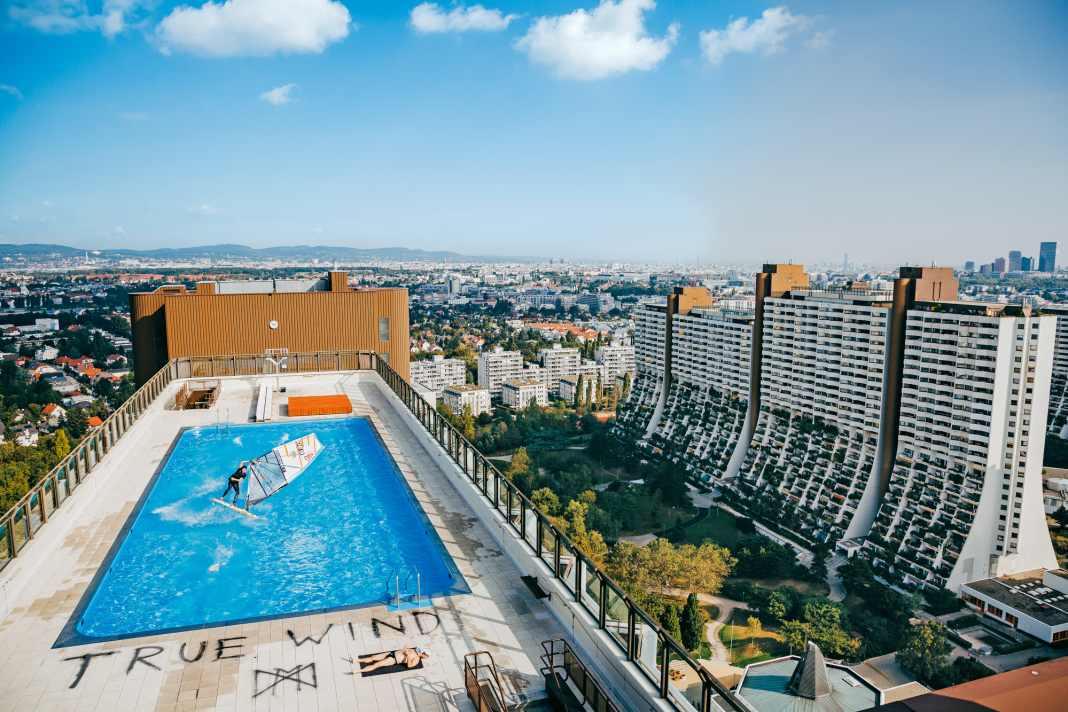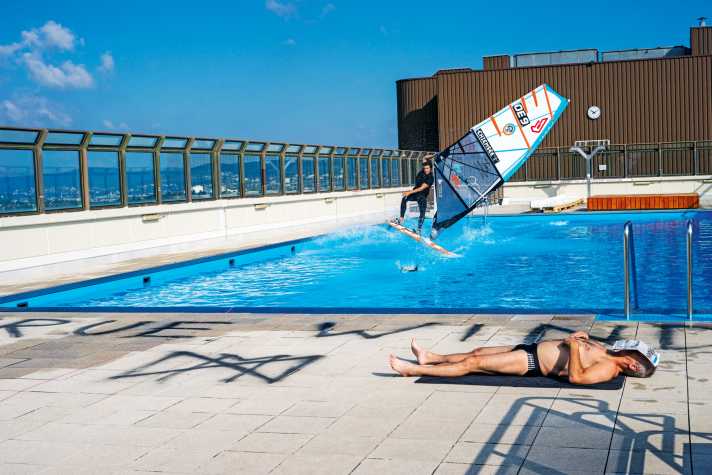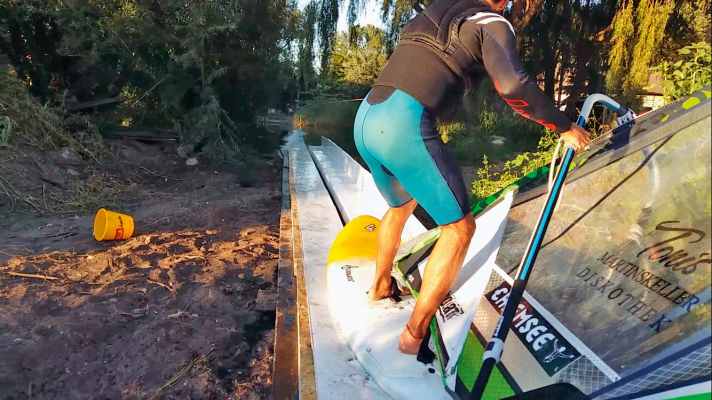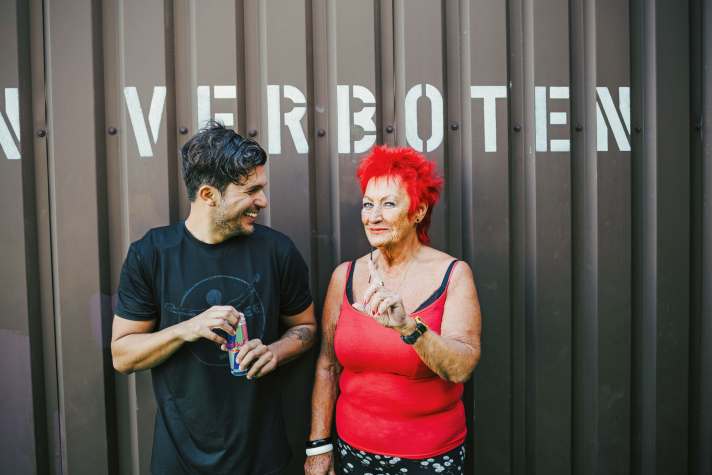





Text: Max Matissek
I remember Alt Erlaa with its gigantic apartment blocks from my childhood. My aunt was one of the almost 13,000 people who live here. In my memories, I spend hours playing Lego with my cousins on her red Persian carpet in the living room. But this time everything was different. I came back to windsurf on the 30th floor on the roof of the building.
The Alt Erlaa residential park in Vienna was built in the 1970s as a project by the state cooperative Gesiba and is one of the largest residential complexes in Austria. It is considered a showcase model of a satellite town in the city - with a complete infrastructure.
The three huge rows of buildings each cover a length of 400 metres. When you get off the Alt Erlaa underground station and walk through the Kaufpark, a shopping centre, you quickly discover the special charm of the complex: people of different origins, ages and faiths live here peacefully together.
Spot check above the rooftops of Vienna
I walked past a Viennese café where a couple of Hackler (labourers) were sitting at the bar. They were tearing pieces off their rolls, dipping them into their goulash and drinking contentedly from their sides. A mature and strikingly dressed lady with red-coloured hair pushed past me and took a pleasurable drag on her Tschick (cigarette). Behind her I met two greying gentlemen - Mr Pausackl and Mr Heiss. After several phone calls and an act of persuasion, I managed to get the property management of Alt Erlaa interested in my new True Wind project. We greeted each other and continued towards Block C, where I wanted to carry out an initial spot check. They told me stories about the residential park and I told them about True Wind:
My True Wind project is about creating different windsurfing images, making windsurfing moves in environments where it's actually impossible. A True Wind picture should tell a very special story. You should have to look at it twice before you understand it and, ideally, still be able to discover something new after the tenth viewing.
Images other than beach and palm trees
After 16 years of windsurfing, I have realised that the classic photos of windsurfers in Hawaii or Cape Town are simply repetitive. The action is great, but the only thing that changes from picture to picture and year to year is usually the colour of the sail and at most the surfers themselves. Don't get me wrong, Maui and Cape Town are windsurfing meccas, they provide fantastic conditions and the action on the water is great. I travel to South Africa myself every winter and take pictures and videos there, but over time I've grown a desire to do something different.
I wanted my photos to be more than just windsurfing clichés with beaches and palm trees: interesting, unusual things like architecture, shapes, colours and people in creative environments. Something like street style snowboarding, wakeboarding or skating. By using a cable winch and jumps, including artificial approaches, I am flexible and can windsurf at spots where it was previously physically impossible. This creates a paradoxical sight for the viewer - windsurfing in places where a windsurfer would normally have no business being.

The preparation: MacGyver's heirs
The two caretakers nodded with conviction. We were now on the 27th floor of the C block. This is the westernmost part of the three 400 metre-long buildings. The view over the Vienna skyline was brilliant. I was thrilled! I really wanted to surf here and produce the next image in the True Wind series.
I joined the men and was full of anticipation. However, there was a small catch: the pool was only 25 metres long. To get enough speed for a move and land in the water, I would need at least 40 metres. I knew I had to extend the pool somehow. Had I gone too far out on a limb with my commitment to the co-operative and sponsors?
I really wanted to manage to surf up there. I was somehow convinced that I could find a solution, but at the same time I doubted that it could work. I played through all the possible options in my head and consulted with friends. I thought about possible approaches outside the pool: Via taxiways, from an additional pool, via synthetic fibres soaked in water, summer ski surfaces and so on. But how, where and when should I test all this? If I couldn't do it, I'd be screwed...
But I still had an ace up my sleeve: Flo Schertler, the man who had already constructed a divisible ski jump for me within three days for my first project - in which I had windsurfed in an old canal under the ground in Vienna. He's something of an extreme sports MacGyver, has his own carpentry and tinsmith's workshop at home and I knew that he loves such crazy ideas. Oh yes, and he lives by a pond.
"Oida, 25 metres is very, very short. Even with an artificial twelve metre approach. It's not normally possible to get up to speed and make a move in such a short distance, even with a hardcore hack and wind force ten. And then you should land in the pool and not behind it. But come to me - we'll think of something!"
A garden is levelled for the project
We decided in favour of a wooden construction with a fin slot and crash barrier and immediately started the carpentry work. For the surface material, we agreed on thin plastic panels, which we had already used before for my True Wind-Kicker in Vienna's underground. We knew that the material is slippery when you ride over it with a windsurf board at top speed. However, whether the resistance of the boards would also allow us to ride off quickly was initially a big question mark.
As we wanted to test the approach and the ground had to be as level as it would later be on the roof, we levelled the ground next to Flo's pond with an excavator, pulled two twelve-metre-long metal rails into position and built the approach on them. But after the first tests came the big disillusionment: although the cable winch was at full throttle, the acceleration on the approach was simply too poor. Twelve metres of wooden ramp plus half of the pool were apparently just not enough. We only had a few days until the shoot and had to come up with something.

True wind or true fail?
Decision day, 6.15 am. We heave my surfboard, mast, boom and sail up the cold, rusty fire escape. We are on the highest point of the building beyond floor 27. For the outro shot of the video, I am supposed to stand on the edge of the roof in the sunrise and look out over Vienna, like Batman with his spread bat wings.
The morning dew makes the metal ledge I'm about to climb on a little slippery. Next to it is a 100 metre drop into the abyss. The gusts of wind are weak, but come irregularly from different sides and make everything a little unpredictable. As I rig my equipment, I realise that a certain tension is building up inside me. I look cautiously into the distance and carefully balance my equipment along the jetty until, after 30 minutes, we have our first photo in the can.
Unfortunately, there have been many times in the history of Alt Erlaa that someone has jumped to their death from here. So it's no wonder that the building management receives several calls from alert residents within a very short space of time and we are immediately contacted by security staff.
Viennese originals as extras
7.30 am: The entire team is now assembled on Block C, where we want to take the main shot. The setup is ready: winch, pool and, of course, the runway.
Before we start, I spray "True Wind" with black Montanas under the pool. I talk through everything one last time with the photographers Ulrich Sperl, Rudy Dellinger and Vincent Forstenlechner and coordinate the process with cameraman Philipp Reiterer from "Enjoy the Soup". The extras for the pictures arrive: The red-haired lady Sigie is around 70 and incredibly young at heart. She knows how to flirt with surfers and of course smokes chain again. Bertl is 60 years old, a sun worshipper and one of the most important men in the apartment complex: the caretaker. Both are veterans of Alt Erlaas and my favourite characters for pictures and videos.

The set is getting bigger and bigger, and in addition to my great helpers and the cameramen, a few officials from the residential complex join us. Everyone is looking forward to the first attempt. Will it work?
Surfing into happiness with dishwashing liquid
8:00 am. The final secret ingredient, washing-up liquid, is used to perfect the recipe for True Wind II and ensure that I can accelerate better on the twelve-metre-long approach this time - if everything goes right, I'll have 50 km/h on the speedometer at the take-off. So I spray my board with it, pour a bucket of water over the approach and make sure it's completely wet - after all, I want to avoid getting stuck somewhere in front of the pool and crashing at all costs.
After the cross check, I'm "ready to go", standing with both feet in the loops, holding my sail with one hand and the handle of the rope in the other. I give Matthias Erlacher a signal at the winch. He gives full throttle. The moped engine of the winch revs up and howls loudly between the wind protection walls of the pool. The board starts to slide slightly and the tension on my outstretched arm increases. With my other arm, I hold the sail close to my body to create as little resistance as possible in the wind with the 4.4 square metres of sail area. At this moment, it always seems to me as if the surface of my surfboard is sliding over the thin film of water on the boards in slow motion - like a catapult that you pull downwards before it shoots the load away. A fraction of a second later, I click off. With my front leg, I press the nose of my Fanatic skate against the side wall to gain control of the equipment and prepare for the drop into the pool. I concentrate on my body tension. The board has to land as flat as possible when I enter the water to maximise my speed and accelerate further.
After exactly 12.5 metres, I have to jump off. If I let go too late, I wouldn't be able to slow down and would crash into the other end of the pool. So I keep my focus to coordinate the jump.
As I let go of the winch handle, I pull my rig a little closer to my hull and push it forwards into the airstream. I jump off and the sudden back pressure in my sail catapults me out of the water in a flash.
Abstract reality
We are jubilant! Everyone is visibly relieved and surprised at how well it worked. For the rest of the day, I repeat everything a hundred times until all the photos are in the can from different perspectives. My team supports me and cheers me on.
When I get home after a long day, I am overjoyed at the success of the project and grateful for the wonderful new experiences. I am flashed that this abstract idea could become reality. And I owe it all to my fantastic team, who pulled together with me from the very beginning.
As I fall into bed dead tired, I'm already dreaming of True Wind III. Who knows which unusual spot I'll end up at.
This text first appeared in surf 3/2017

